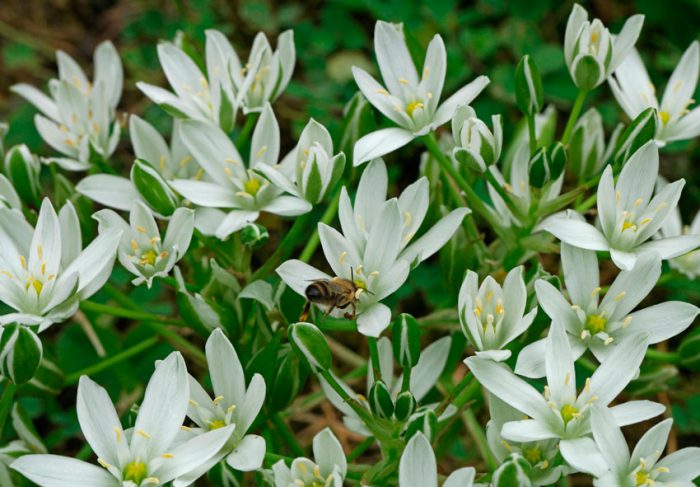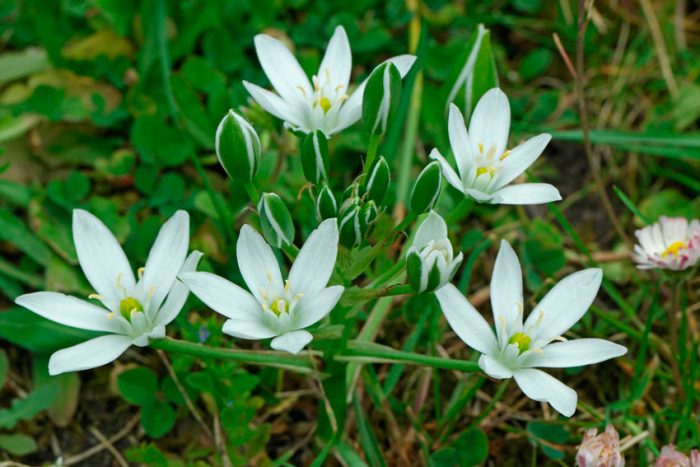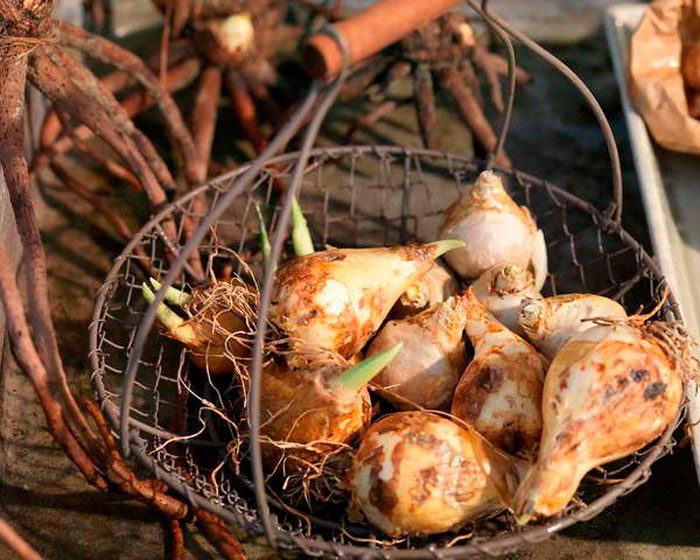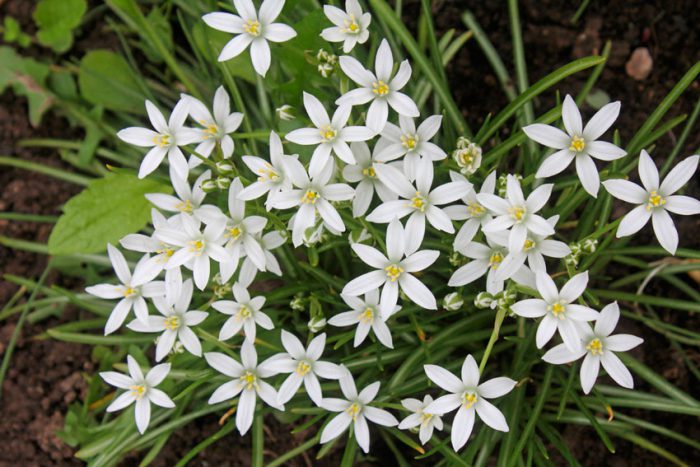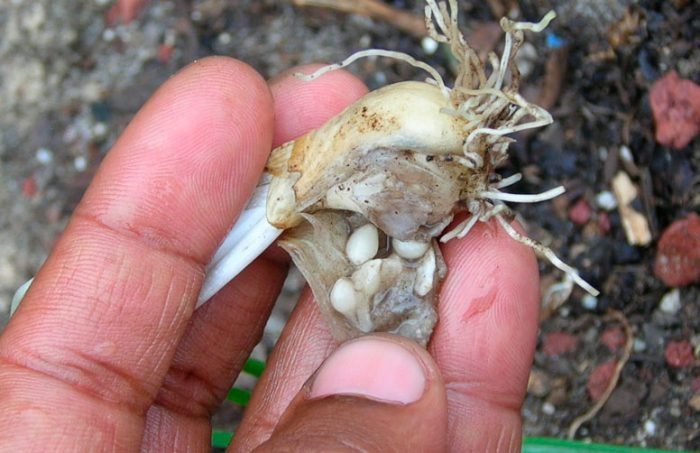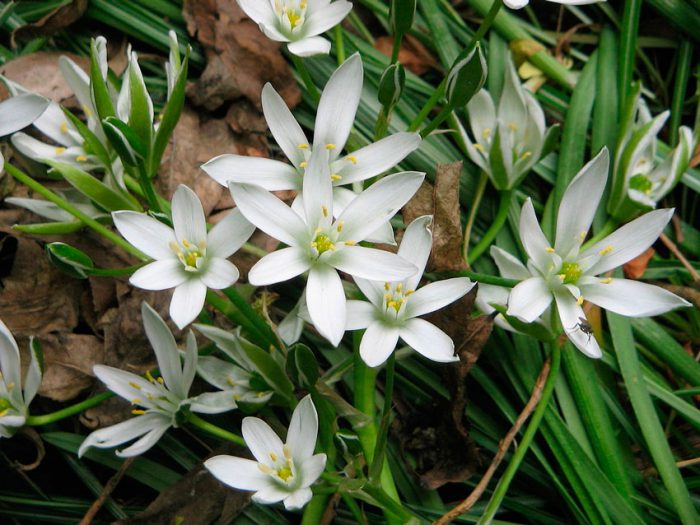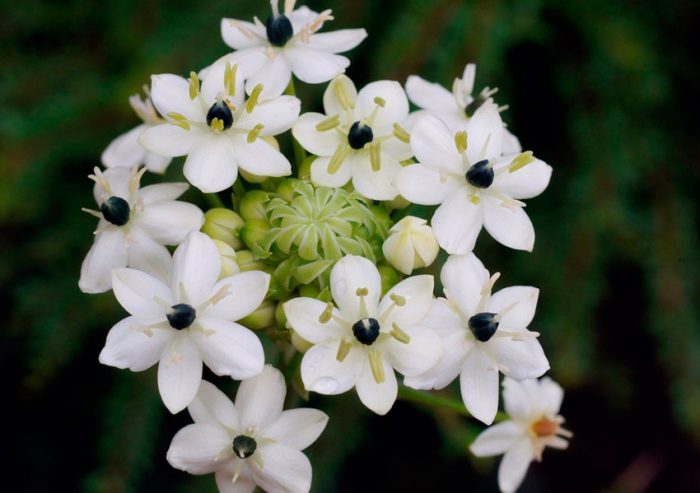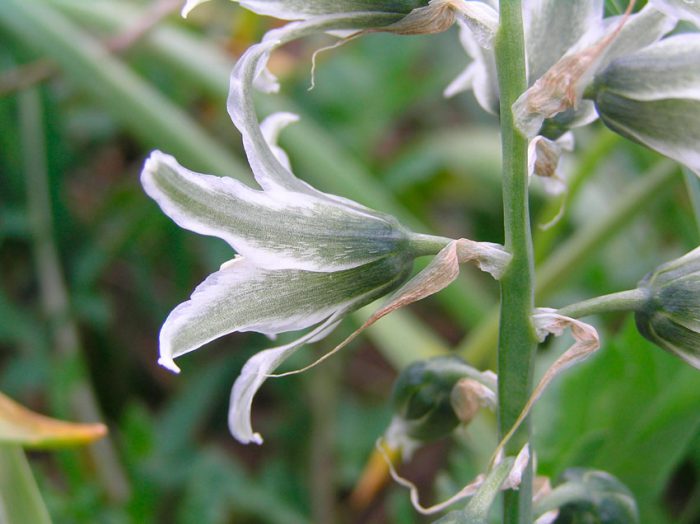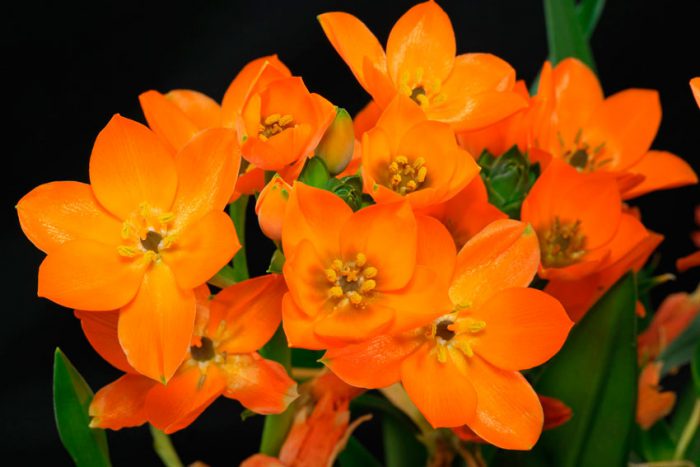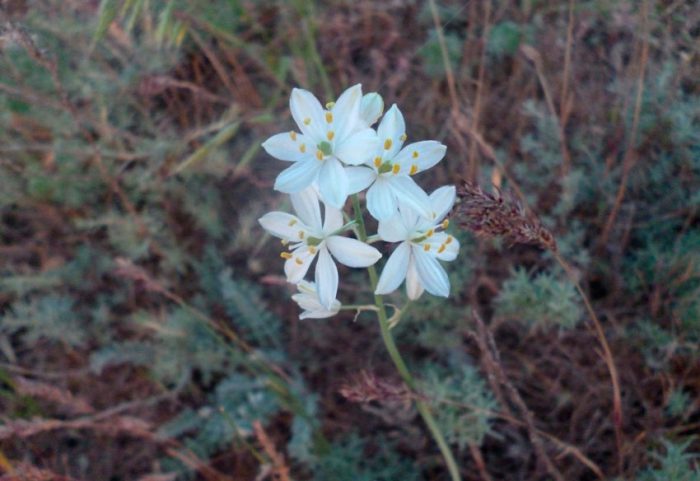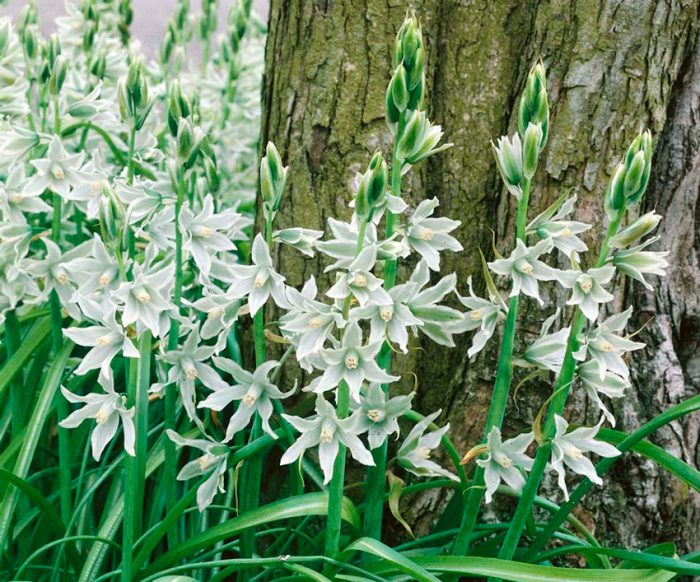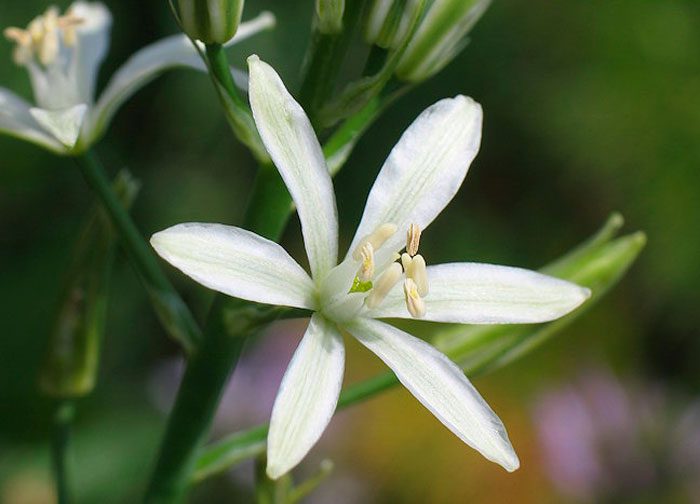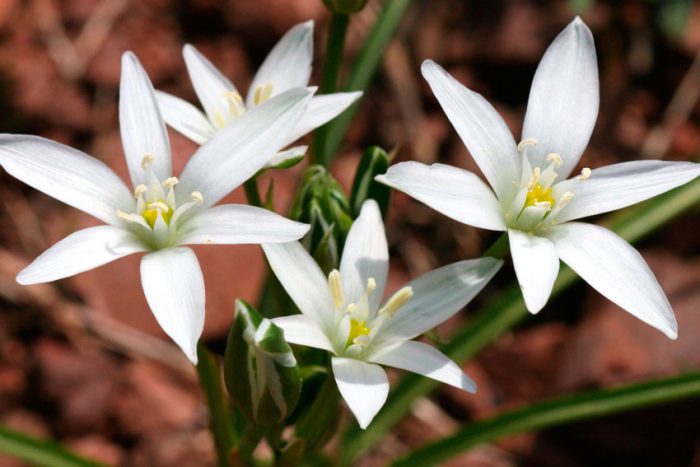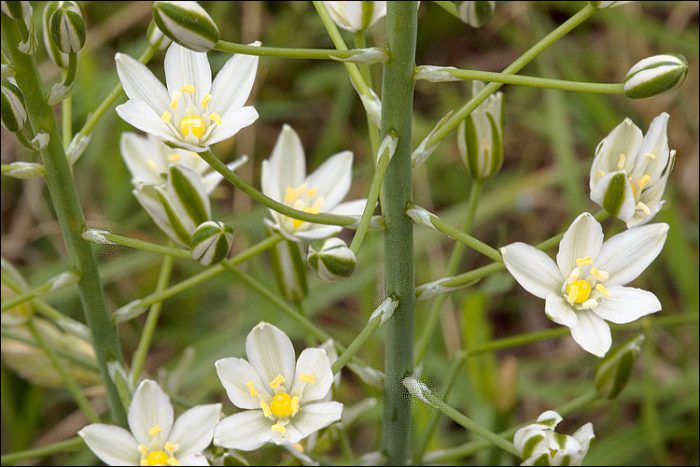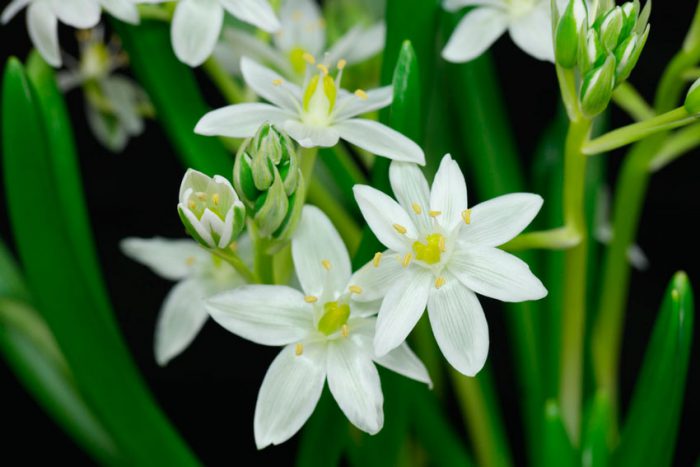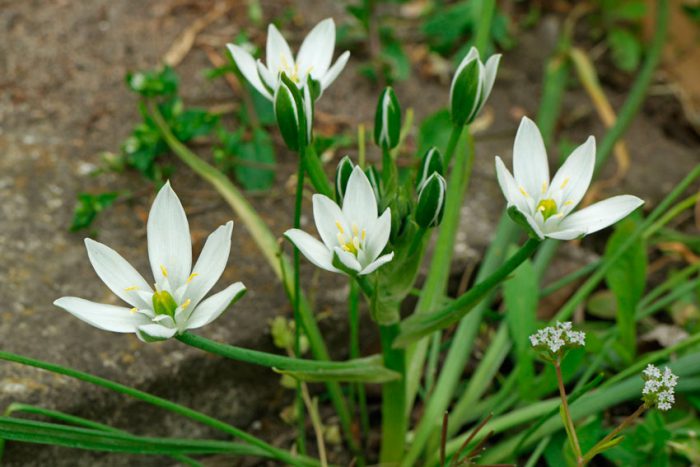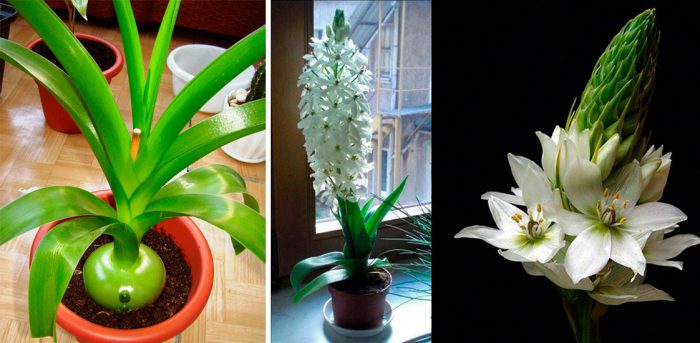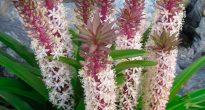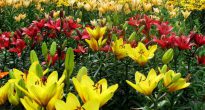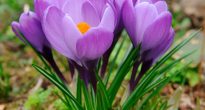Bulbous herbaceous perennial plant of the poultry plant (Ornithogalum), or ornithogalum, is a representative of the subfamily hyacinths of the asparagus family. In natural conditions, it can be found in the subtropical and temperate regions of South Africa, the Mediterranean and Western Asia. 1 species of ornithogalum grows in South America, several in Eurasia and 4 in North America. In total, there are about 150 species of poultry farms. The Latin name of the plant consists of two words: "ornis", which translates as "bird" and "gala" - meaning "milk", resulting in "bird's milk". This plant has flowers of a very unusual star-shaped form, which is why it is called the "star of Bethlehem" in England and the "milk star" in Germany.
Content
- 1 Features of the poultry farm
- 2 Planting a poultry farm in open ground
- 3 Poultry care in the garden
- 4 After flowering
- 5 Poultry properties
- 6 Types and varieties of poultry with photos and names
- 6.1 Arabian poultry (Ornithogalum arabicum)
- 6.2 Poultry Boucher (Ornithogalum boucheanum)
- 6.3 Doubtful birdhouse (Ornithogalum dubium)
- 6.4 Fisher's birdhouse (Ornithogalum fischerianum)
- 6.5 Wilted birdhouse (Ornithogalum nutans)
- 6.6 Pontic poultry farm (Ornithogalum ponticum), or Pyrenean poultry farm (Ornithogalum pyrenaicum)
- 6.7 Saunders' birdhouse (Ornithogalum saundersiae)
- 6.8 Poultry poultry Narbonne (Ornithogalum narbonense)
- 6.9 Large bird poultry (Ornithogalum magnum)
- 6.10 Pyramidal birdhouse (Ornithogalum pyramidale)
- 6.11 Balansa poultry farm (Ornithogalum balansae), or Schmalhausen poultry farm (Ornithogalum schmalhausenii)
- 6.12 Umbrella poultry (Ornithogalum umbellatum)
- 6.13 Tailed poultry (Ornithogalum caudatum), or Indian onion
Features of the poultry farm
The height of the ornithogalum bush can vary from 0.3 to 0.85 m. The diameter of the bulbs is 2–5 centimeters, and their shape can be ovoid, round or oblong. There are dense covering scales on their surface. Basal leaf plates of a belt-like or linear shape with a whitish central vein grow somewhat earlier than the flower arrows. There are species in which foliage grows in the autumn, and it remains on the bush in the winter, and dries up in the summer. Inflorescences of racemose or corymbose form consist of light yellow or white flowers, they have no aroma, but a strip of green color passes along the front surface of the tepals. The fruit is a box with flat, rounded black seeds inside.
If you are going to grow this plant, then do not forget that there are poisonous species, they contain cardiac glycosides, and unidentified alkaloids may also be present. Other types of sprouts and bulbs are edible and eaten like asparagus. About 10 species of ornithogalum are cultivated.
Below it will be described in detail how to plant, grow and propagate this flower, as well as talk about its medicinal properties.
Planting a poultry farm in open ground
What time to plant
It is quite possible to grow a poultry garden from a seed, but it will begin to bloom only 4–5 years after the emergence of shoots. Experienced gardeners recommend buying bulbs in a specialized store and planting them in open soil in September or August. Planting and growing this plant is very simple, so even an inexperienced gardener can handle it.
Landing features
It is recommended to choose a well-lit area for this flower, but it may well grow in a shaded area. The soil must be permeable, so you should choose not clay, but sandy soil. The depth of the planting bulbs should be from 6 to 10 centimeters, while a distance of 15 to 20 centimeters must be kept between them. The onion must be immersed in the finished hole and covered with earth. Then the planted plants need to be watered well. Then you just have to wait until the shoots appear in the spring.
Poultry care in the garden
There is nothing difficult in caring for ornithogalum. It just needs to be regularly watered in moderation. In the event that water stagnates in the soil, then rot will appear on the bush, the inflorescences will die off, while the leaf plates will turn yellow. Watering should be reduced during flowering and seed bolls. Such a plant begins to bloom, depending on the species, from the first to the last days of May, the duration of flowering is about 20 days.
In the fall, it is recommended to feed this flower using organic fertilizers. However, if the soil in the area where it grows is saturated with nutrients, then feeding can be omitted.
In some cases, a spider mite appears on the bushes. Insectoacaricides are used to destroy it. Also, aphids sometimes settle on this plant, from which you can get rid of such means as Antitlin and Biotlin. However, do not be intimidated, it is relatively easy to care for this flower.
How to transplant
In order for the plant to develop normally, it needs to ensure timely transplantation. If the plant is not transplanted for a long time, then a lot of children appear at the bulb, and this negatively affects the appearance of the plant. The poultry farm can do without transplants for no more than 6 years, but experts advise to carry out this procedure 1 time in 4 years. During transplantation, children must be torn from the bulb and planted in a new permanent place, which can be sunny or shaded. It is recommended to carry out this procedure in the last days of the summer period or in the spring.
Reproduction of the poultry farm
It has already been said that such a flower can be propagated both by children and by a generative (seed) method. It should be remembered that the seeds need stratification, which should last 3 or 4 months, in this regard, they are sown in open soil before winter in prepared grooves of shallow depth. Seedlings should appear in the spring. If there is a desire, then the poultry farm can be grown through seedlings. Sowing seedlings should be done in early spring. To do this, you can use plastic glasses or a container. Light and loose soil is used to fill the container. After 3 or 4 true leaf plates appear, you need to start hardening the seedlings. To do this, for 16-18 days, they must be taken out to fresh air every day, while the time spent on the outside of the seedlings should be increased gradually. Planting is carried out only when the plants can be in the fresh air around the clock.
After flowering
After the leafy ones completely wither, they will need to be cut off. In mid-latitudes and southern regions, the plant does not need shelter for the winter. However, if the winter period is with little snow and rather frosty, then the area where the ornithogalum grows should be covered with spruce branches.If you grow thermophilic species, which include a dubious bird farm and an Arabian bird farm, then the bulbs must be dug up in the autumn and planted in flower pots or put in a cellar for the winter. They are planted in the garden in the spring.
Poultry properties
Ornithogalum has a wound healing, analgesic and antimicrobial effect. With the help of this plant, they treat bruises and wounds, eliminate inflammatory processes and painful sensations in the joints, cleanse the body of salt, treat headaches, and also use it for edema. If such a flower is grown at home, then it will purify the air in the apartment, since it contains a large amount of phytoncides.
It should be borne in mind that only the crested poultry farm, also called the Indian onion, has healing properties. Absolutely all parts of this plant, including flowers and bulbs, are healing. Moreover, such properties do not appear immediately, but only in the second year of life.
Types and varieties of poultry with photos and names
Below are descriptions of the most popular species of ornithogalum.
Arabian poultry (Ornithogalum arabicum)
The homeland of this species is the Mediterranean. Under natural conditions, it can be found in Israel, in this country the poultry farm is translated as "hawk milk". The basal rosette consists of pale green linear leaf plates. The height of the peduncle is about 0.85 m. The loose, low-flowered inflorescence consists of flowers reaching 5 centimeters in diameter, with a white color and long pedicels. Cultivated since 1574
Poultry Boucher (Ornithogalum boucheanum)
In the wild, this species can be found in the European part of Russia, in Asia Minor, in the Balkans and in Moldova, while it prefers to grow in river valleys. This species was named in honor of P.K.Bush, who in the first half of the 19th century was a botanist of the Berlin Botanical Garden. The bush in height can reach no more than half a meter. The width of the grooved linear leaf plates varies from 0.5 to 1.5 centimeters, their color is rich green, while there is a longitudinal light strip on the inner surface. The composition of racemose inflorescences includes from 20 to 50 flowers, the edge of the tepals in which is wavy.
Doubtful birdhouse (Ornithogalum dubium)
The homeland of this orange poultry farm is South Africa. The pyramidal shape of the cyst-shaped inflorescence consists of flowers of orange, red, rich yellow or white color, while the bases of the pericarp segments have a nut-bronze or green color. Greenish-yellow leaf plates are slightly pubescent along the edge. Stems with flowers are often used when drawing up bouquets, the fact is that they are able to keep fresh for a long time. This species is not cultivated in European countries. Most popular varieties:
- Ballerina. This variety can be grown both in the garden and indoors. The color of the flowers is rich orange.
- Sunshine. The color of the flowers is yellow.
Fisher's birdhouse (Ornithogalum fischerianum)
Under natural conditions, this species can be found in Kazakhstan, Western Siberia and the European part of Russia, while it prefers to grow on salt marshes and in wormwood steppes. This species was named after a botanist who was famous in the 19th century. The bush can reach a height of 0.6 m, and the length of racemose inflorescences is about 0.25 m, they include from 8 to 20 flowers. On the front surface of the white leaf plates, there is a narrow strip of green color.
Wilted birdhouse (Ornithogalum nutans)
Under natural conditions, it can be found in the Mediterranean, the Balkans, Scandinavia and the European part of Russia. The height of the bush is about half a meter. A whitish strip runs along the inner surface of the greenish-gray leaf plates. Dropped inflorescences consist of 5–12 flowers. On the outer surface of the perianth leaves there is a wide strip of green color. Cultivated since 1600
Pontic poultry farm (Ornithogalum ponticum), or Pyrenean poultry farm (Ornithogalum pyrenaicum)
Under natural conditions, it can be seen in the Crimea and the Caucasus, while such a plant prefers to grow on rocky slopes, on the edges of bushes, in fields and along roads. The height of such flowers reaches almost 100 centimeters. The color of the leaf plates is greenish-gray. The length of the inflorescences is about 0.4 m and their width is about 7 centimeters. In the composition of such inflorescences there can be from 30 to 95 flowers, along the outer surface of the perianth leaves of which a narrow strip of green color passes.
Saunders' birdhouse (Ornithogalum saundersiae)
This species can only be found in the wild in South Africa, so its frost resistance is quite low. The length of dark green or greenish-gray leaf plates is about 0.6 m. Shoots can be up to 100 centimeters high. The pyramidal inflorescences consist of white or cream-colored cupped flowers with very beautiful black or greenish-black ovaries. Flowers are used for cutting and for creating bouquets. This type is different in that it has a constant need for moisture.
Poultry poultry Narbonne (Ornithogalum narbonense)
In the wild, it can be found in Southern Europe, North Africa and Western Asia, while these flowers are preferred to grow on clay soil. The height of the bush can vary from 0.4 to 0.8 m. The color of the linear leaf plates is greenish-gray. The composition of racemose inflorescences can include up to 50 medium-sized white flowers; on the outer surface of the perianth leaves there is a thin strip of green color. Flowering is observed in the first days of June.
Large bird poultry (Ornithogalum magnum)
In the wild, you can meet in the Ciscaucasia and Transcaucasia. The color of the leaf plates is pale green. White flowers have a narrow strip of green. Loose racemose inflorescence consists of 20-60 flowers.
Pyramidal birdhouse (Ornithogalum pyramidale)
In the wild, this species can be found in Central Europe and the Balkans. The height of the bush can vary from 0.3 to 1 meter. The leaf plates are colored greenish-gray. On the outer surface of the white leaf plates of the perianth there are stripes of green color. The length of racemose inflorescences can vary from 0.25 to 0.5 m, while they include from 20 to 100 flowers. This species has been cultivated since 1574.
Balansa poultry farm (Ornithogalum balansae), or Schmalhausen poultry farm (Ornithogalum schmalhausenii)
This species grows in the subalpine, as well as the alpine belt of the Caucasus and Asia Minor. This species was named after a well-known botanist and scientist of the 19th century - Balance. The bush in this species can reach a height of only 0.1 m. Crescent-curved grooved leaf plates can be colored olive or green. In height, the peduncle reaches only 5 centimeters, it has 3 white flowers with a strip of green, the diameter of which is 3 centimeters.
Umbrella poultry (Ornithogalum umbellatum)
This type in culture is one of the most popular. Under natural conditions, it can be found in the forests of the Western Mediterranean, Asia Minor and Western and Central Europe. The bush can reach a height of about 0.25 m. Grooved linear leaf plates have a longitudinal strip of whitish color. Umbellate inflorescences consist of 15–20 small (diameter about 25 mm) white flowers with a wide longitudinal green strip.
Tailed poultry (Ornithogalum caudatum), or Indian onion
Such a flower has medicinal properties, although it is poisonous. His homeland is South Africa. The sprawling bush consists of wide, flat, belt-like flat leaf plates, the length of which can reach 0.8 m. The length of the brushes, consisting of 50-100 flowers, can reach 100 cm. Fragrant white flowers have a pale green center.
Also, gardeners cultivate such types of poultry as: arched, fringed, Gusson, mountain, flat-leaved, Shelkovnikov, Zintenis, Temp, Transcaucasian, thyrsoid and Voronov.

